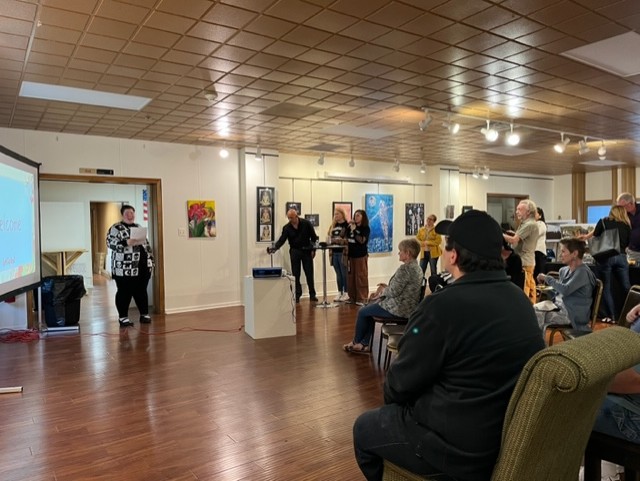|
Back to Prevention Stories
Recovery and Resilience
Hosted by:
Downriver Council for the Arts

Please briefly describe your Communities Talk activity.
We asked youth to participate in a photo voice project with the theme of resilience. A short narrative was created for each photo by the youth. These were then given to a local art gallery and put on display. In addition, art was submitted by local artists that work with this gallery. They were given the theme of Recovery and Resilience. Art was displayed for over a week culminating in our event, in which we had presenters, including one of our youth, a former member of the Detroit Highwaymen and a young man with autism who had art on display and spoke about his inspiration for the piece. We had food and a local band played. We had resources and information about the coalition.

How does alcohol and other drug misuse affect your community?

We were making really great progress with underage drinking and since COVID we are seeing it go back up. We utilize the MiPHY survey, but promised our schools we would not share their information without their permission. A link to the county level data is here: https://mdoe.state.mi.us/schoolhealthsurveys/externalreports/countyreportgeneration.aspx. We definitely have rising concerns as alcohol and drug use seem to be "a rite of passage, everybody is doing it and it's not that big of a deal". At least these seem to be the attitudes from many in the community. Those most concerned are those working with youth and seeing the impact. With the commercialization of marijuana, the advertising is everywhere, further impacting youth.

Which prevention strategy(ies), as defined by SAMHSA’s Center for Substance Abuse Prevention, best fit your Communities Talk activity?
- Community-Based Process Strategy - focuses on enhancing the capacity of the community to address AOD issues through organizing, planning, collaboration, coalition building, and networking.
- Information Dissemination Strategy - focuses on improving awareness and knowledge of the effects of AOD issues on communities and families through “one-way” communication with the audience such as speaking engagements, health fairs, and distribution of print materials.
- Education Strategy - focuses on “two-way” communication between the facilitator and participants and aims to improve life/social skills such as decision making, refusal skills, and critical analysis.
- Alternative Strategy - focuses on redirecting individuals from potentially problematic situations and AOD use by providing constructive and healthy events/activities.

What goal(s) did you hope to accomplish with your Communities Talk activity?
- Hold meetings or discussion groups on alcohol and/or other drug misuse prevention.
- Build coalitions with other agencies or programs to reduce and prevent alcohol and/or other drug misuse.

Did you accomplish your goal(s)?
Yes

What challenge(s) did you face in planning your activity this year?
- Lack of interest from the community
- This event was promoted for many months and yet, we only had 35 people attend. We pushed it through many avenues and the art gallery did as well.

How did you overcome these challenges?
Although attendance was low, we recorded the main presenter and will be posting on social media and will put it on YouTube. We will do a better job for future of getting information to cable and newspapers and personally inviting folks.

What are your next steps?

- Host follow-up meetings or activities
- Expand our coalition with new partnerships in the community
- Conduct research efforts to learn more about issues in our community

If you’ve conducted Communities Talk activities in prior years, how has your repeated participation contributed to progress in achieving your prevention goals?
These grants provide opportunities to do events and to be creative. We utilize the success stories to learn from others also. The planning guide is very helpful.

Organizations that conduct Communities Talk activities often involve other organizations in the planning and execution of events. Please indicate which type(s) of organizations you involved in your activity planning.

Which of the following best describes the primary audience(s) for your Communities Talk activity?
- Parents
- Teachers or other education staff
- Youth leaders (e.g., coaches, parks and recreation personnel, and scouting leaders)

How did you reach and engage your primary audience(s) to encourage them to participate in your activity?
The art gallery hosting the event reached out to artists they work with and invited them to create a piece that spoke to them about recovery or resilience. A second gallery also reached out to their artists inviting them to participate. We met with our youth and asked them about doing a photo voice project and we invited schools to share the call for art with their art classes. In addition, we reached out to the main presenter after meeting him at a school event and asked him to present.

Which Communities Talk resources (or other SAMHSA resources) were most helpful for your activity?

- Communities Talk website
- Communities Talk planning guides
- Communities Talk toolkits
- The website helped us to learn from others and the planning guide helped us to get and stay organized.
|
|